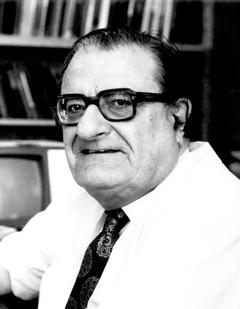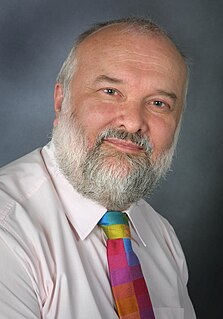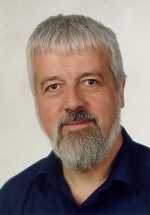Related Research Articles
Computational chemistry is a branch of chemistry that uses computer simulation to assist in solving chemical problems. It uses methods of theoretical chemistry, incorporated into computer programs, to calculate the structures and properties of molecules, groups of molecules, and solids. It is essential because, apart from relatively recent results concerning the hydrogen molecular ion, the quantum many-body problem cannot be solved analytically, much less in closed form. While computational results normally complement the information obtained by chemical experiments, it can in some cases predict hitherto unobserved chemical phenomena. It is widely used in the design of new drugs and materials.

MOLPRO is a software package used for accurate ab initio quantum chemistry calculations. It is developed by Peter Knowles at Cardiff University and Hans-Joachim Werner at Universität Stuttgart in collaboration with other authors.
Gaussian is a general purpose computational chemistry software package initially released in 1970 by John Pople and his research group at Carnegie Mellon University as Gaussian 70. It has been continuously updated since then. The name originates from Pople's use of Gaussian orbitals to speed up molecular electronic structure calculations as opposed to using Slater-type orbitals, a choice made to improve performance on the limited computing capacities of then-current computer hardware for Hartree–Fock calculations. The current version of the program is Gaussian 16. Originally available through the Quantum Chemistry Program Exchange, it was later licensed out of Carnegie Mellon University, and since 1987 has been developed and licensed by Gaussian, Inc.
Electronic correlation is the interaction between electrons in the electronic structure of a quantum system. The correlation energy is a measure of how much the movement of one electron is influenced by the presence of all other electrons.
Austin Model 1, or AM1, is a semi-empirical method for the quantum calculation of molecular electronic structure in computational chemistry. It is based on the Neglect of Differential Diatomic Overlap integral approximation. Specifically, it is a generalization of the modified neglect of differential diatomic overlap approximation. Related methods are PM3 and the older MINDO.

PM3, or Parametric Method 3, is a semi-empirical method for the quantum calculation of molecular electronic structure in computational chemistry. It is based on the Neglect of Differential Diatomic Overlap integral approximation.

Michael James Steuart Dewar was an American theoretical chemist.

Spartan is a molecular modelling and computational chemistry application from Wavefunction. It contains code for molecular mechanics, semi-empirical methods, ab initio models, density functional models, post-Hartree–Fock models, and thermochemical recipes including G3(MP2) and T1. Quantum chemistry calculations in Spartan are powered by Q-Chem.
Semi-empirical quantum chemistry methods are based on the Hartree–Fock formalism, but make many approximations and obtain some parameters from empirical data. They are very important in computational chemistry for treating large molecules where the full Hartree–Fock method without the approximations is too expensive. The use of empirical parameters appears to allow some inclusion of electron correlation effects into the methods.
Ab initio quantum chemistry methods are computational chemistry methods based on quantum chemistry. The term ab initio was first used in quantum chemistry by Robert Parr and coworkers, including David Craig in a semiempirical study on the excited states of benzene. The background is described by Parr. Ab initio means "from first principles" or "from the beginning", implying that the only inputs into an ab initio calculation are physical constants. Ab initio quantum chemistry methods attempt to solve the electronic Schrödinger equation given the positions of the nuclei and the number of electrons in order to yield useful information such as electron densities, energies and other properties of the system. The ability to run these calculations has enabled theoretical chemists to solve a range of problems and their importance is highlighted by the awarding of the Nobel prize to John Pople and Walter Kohn.

Henry Stephen Rzepa is a chemist and Emeritus Professor of Computational chemistry at Imperial College London.
The fragment molecular orbital method (FMO) is a computational method that can compute very large molecular systems with thousands of atoms using ab initio quantum-chemical wave functions.

Plumbane, PbH4, is a metal hydride and group 14 hydride composed of lead and hydrogen. Plumbane is not well characterized or well known, and it is thermodynamically unstable with respect to the loss of a hydrogen atom. Derivatives of plumbane include lead tetrafluoride, PbF4, and tetraethyllead, (CH3CH2)4Pb.
Quantum chemistry composite methods are computational chemistry methods that aim for high accuracy by combining the results of several calculations. They combine methods with a high level of theory and a small basis set with methods that employ lower levels of theory with larger basis sets. They are commonly used to calculate thermodynamic quantities such as enthalpies of formation, atomization energies, ionization energies and electron affinities. They aim for chemical accuracy which is usually defined as within 1 kcal/mol of the experimental value. The first systematic model chemistry of this type with broad applicability was called Gaussian-1 (G1) introduced by John Pople. This was quickly replaced by the Gaussian-2 (G2) which has been used extensively. The Gaussian-3 (G3) was introduced later.

Walter Thiel was a German theoretical chemist. He was the president of the World Association of Theoretical and Computational Chemists (WATOC) from 2011.
Minnesota Functionals (Myz) are a group of highly parameterized approximate exchange-correlation energy functionals in density functional theory (DFT). They are developed by the group of Prof. Donald Truhlar at the University of Minnesota. These functionals are based on the meta-GGA approximation, i.e. they include terms that depend on the kinetic energy density, and are all based on complicated functional forms parametrized on high-quality benchmark databases. These functionals can be used for traditional quantum chemistry and solid-state physics calculations. The Myz functionals are widely used and tested in the quantum chemistry community.
The Edwards equation in organic chemistry is a two-parameter equation for correlating nucleophilic reactivity, as defined by relative rate constants, with the basicity of the nucleophile and its polarizability. This equation was first developed by John O. Edwards in 1954 and later revised based on additional work in 1956.
In chemistry, the ECW model is a semi-quantitative model that describes and predicts the strength of Lewis acid–Lewis base interactions. Many chemical reactions can be described as acid–base reactions, so models for such interactions are of potentially broad interest. The model initially assigned E and C parameters to each and every acid and base. The model was later expanded to the ECW model to cover reactions that have a constant energy term, W, which describes processes that precede the acid–base reaction. This quantitative model is often discussed with the qualitative HSAB theory, which also seeks to rationalize the behavior of diverse acids and bases.
Bicycloaromaticity in chemistry is an extension of the concept of homoaromaticity with two aromatic ring currents situated in a non-planar molecule and sharing the same electrons. The concept originates with Melvin Goldstein who first reported about it in 1967. It is of some importance in academic research. Using MO theory the bicyclo[3.2.2]nonatrienyl cation was predicted to be destabilised and the corresponding anion predicted to be stabilised by bicycloaromaticity.
Mario Barbatti is a Brazilian physicist, computational theoretical chemist, and writer. He is specialized in the development and application of mixed quantum-classical dynamics for the study of molecular excited states. He is also the leading developer of the Newton-X software package for dynamics simulations. Mario Barbatti held an A*Midex Chair of Excellence at the Aix Marseille University between 2015 and 2019, where he is a professor since 2015.
References
MNDO
- Dewar, Michael J. S.; Thiel, Walter (1977). "Ground states of molecules. 38. The MNDO method. Approximations and parameters". Journal of the American Chemical Society. 99 (15): 4899. doi:10.1021/ja00457a004.
MNDO/d
- Thiel, Walter; Voityuk, Alexander A. (1996). "Extension of MNDO to d Orbitals: Parameters and Results for the Second-Row Elements and for the Zinc Group". Journal of Physical Chemistry. 100 (2): 616. doi:10.1021/jp952148o. hdl: 11858/00-001M-0000-0027-C145-2 .
- Thiel, Walter (1996). "Perspectives on Semiempirical Molecular Orbital Theory". Advances in Chemical Physics. Advances in Chemical Physics. Vol. 93. pp. 703–757. doi:10.1002/9780470141526.ch10. ISBN 978-0-470-14152-6.
MNDOC
- Cramer, C. J. (2002). Essentials of Computational Chemistry . John Wiley. p. 135.
- Thiel, Walter (1981). "The MNDOC method, a correlated version of the MNDO model". Journal of the American Chemical Society. 103 (6): 1413–1420. doi:10.1021/ja00396a021.
- Thiel, Walter (1981). "MNDOC study of reactive intermediates and transition states". Journal of the American Chemical Society. 103 (6): 1420–1425. doi:10.1021/ja00396a022.
- Schweig, Armin; Thiel, Walter (1981). "MNDOC study of excited states". Journal of the American Chemical Society. 103 (6): 1425. doi:10.1021/ja00396a023.